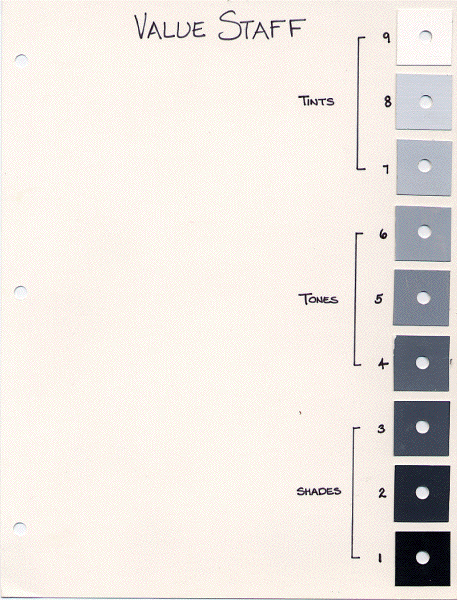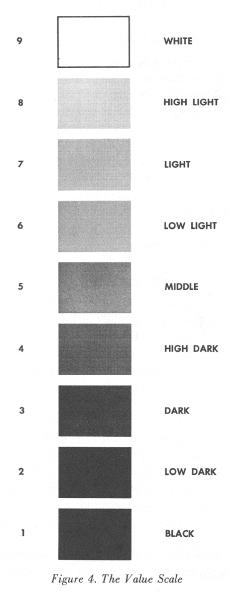The most common problem will be value scales that are predominantly dark — too low in value. Low value swatches will have little contrast between them, and the high values will have abrupt contrasts between them. Since you have no absolute sample for your #5 (mid-value) color, you will have to mix your samples carefully, and then adjust. In practice, this takes longer than expected, but methodical mixing and careful comparisons of contrasts will speed up the refining process.
Another common error, usually a by-product of problem #1, is that the biggest "jump" in value will be between value #8 and #9 — at the top. It is particulalry challenging to control that highest pair — so watch carefully.
Self-crit questions:
— Does my value staff seem very dark? ...very light? ...or successfully balance?
— Is the contrast between the top two samples too abrupt?
— Are the bottom (darkest) two or three samples almost identical?
— Which pair of values has the biggest jump? (the greatest contrast?)
[ You may need to add another sample between these...and remove a sample elsewhere. ]
— Which pair of values are almost identical? Which pair have the least contrast?
[ You may be able to remove one of the two most similar samples. ]
Adjusting samples with GLAZES:
One way to adjust a dried color, without mixing a color from scratch, is to use a glaze color to "pull" the color — to shift its color just a bit. Glazing techniques involve a transparent body of thin color. Use acrylic medium and a small among of correcting color to mix a glaze. Paint it on in a thin, even coat. Let it dry. Then look hard again to see if more adjusting is needed.
For instance, to slightly darken a swatch, mix some acrylic medium...a mound about the size of a dime... along with a very small dab of black paint. Mix well. Then paint a thin even coat on your swatch. NOTE that acrylic medium is milky white while wet — so you don't know what the final color will look like until it dries. This is, admittedly a disavantage to glazing in acrylic.
To slightly lighten a swatch, mix some acrylic medium...a mound about the size of a dime... along with a very small dab of titanium white* paint. Mix well. Then paint a thin even coat on your swatch. NOTE that acrylic medium is milky white while wet — so you don't know what the final color will look like until it dries. This is, admittedly a disavantage to glazing in acrylic.
* Titanium White is on your course supply list. However, for glazing, its not the ideal white. The preferred option is Zinc White, or Transparent Mixing White, both of which use Zinc Oxide as their pigment. Zinc White is transparent, rather than opaque like Titanium White, and thus is better for glazes. Titanium white is generally fine for glazing in a color exercise.


